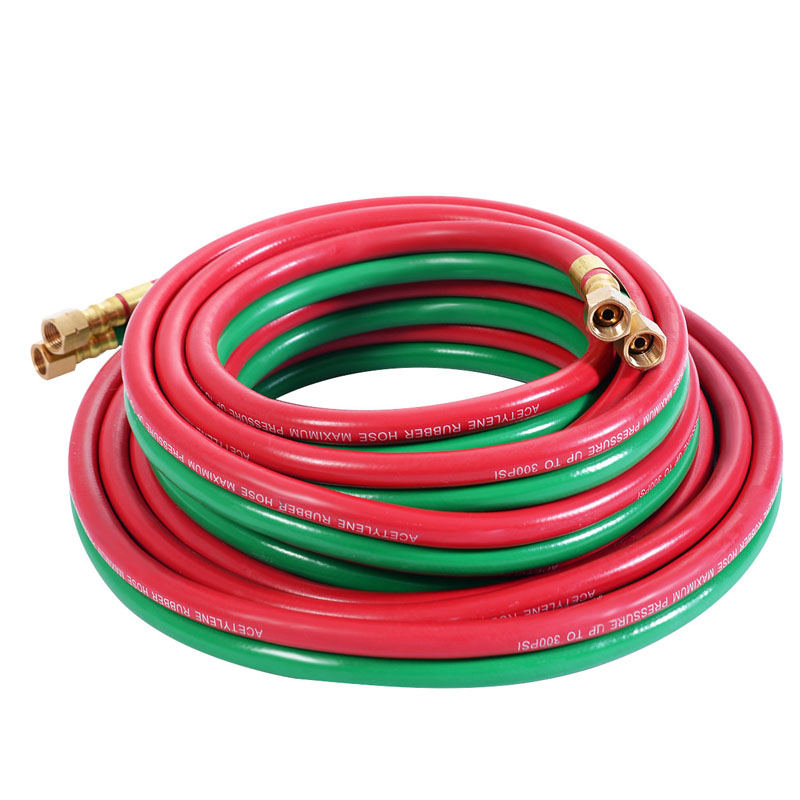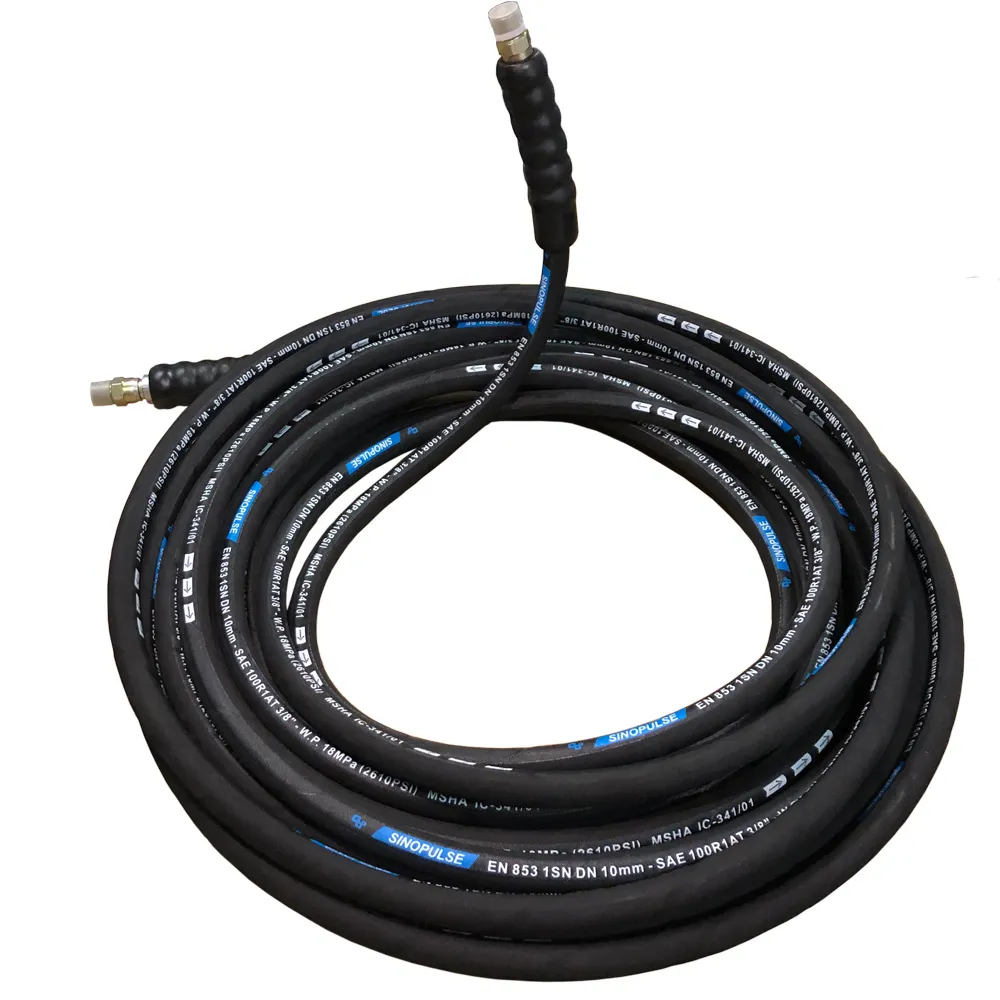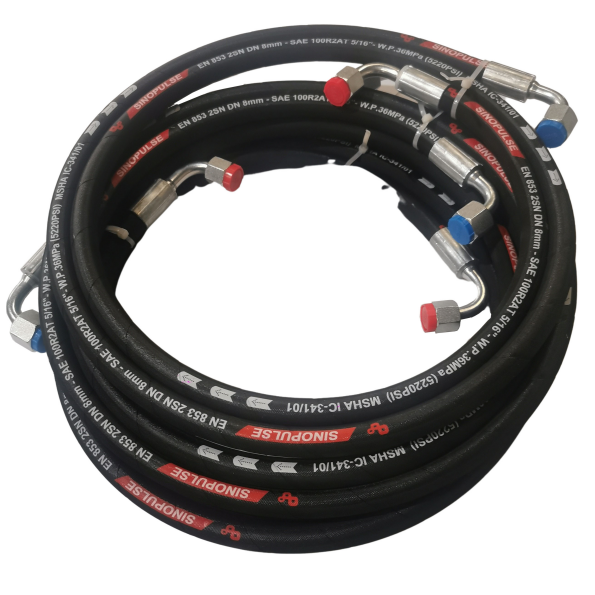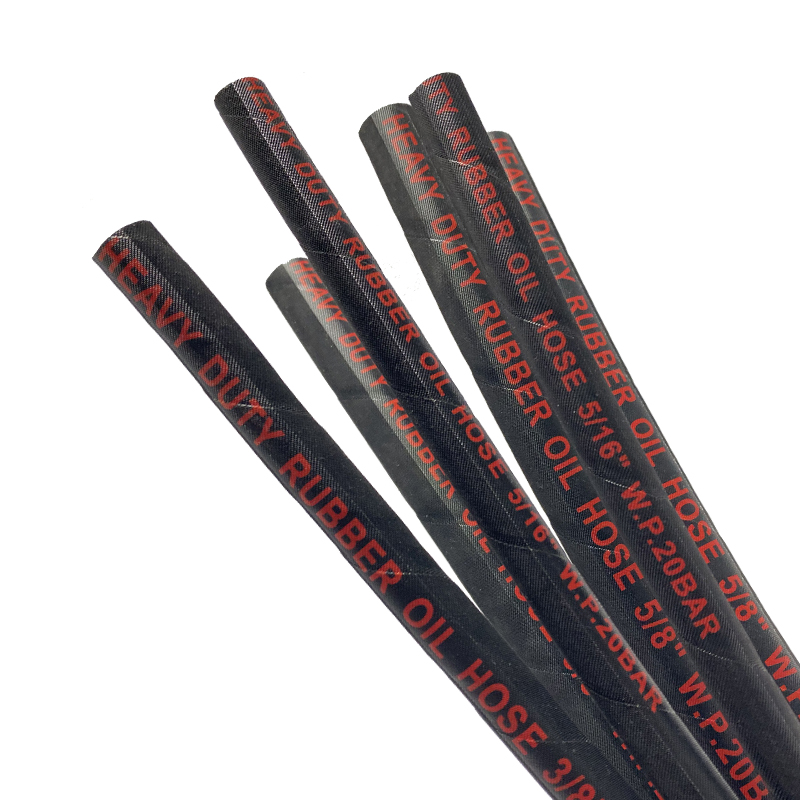Welding Hose
A welding hose is a type of flexible hose designed to safely transport gases used in welding, cutting, and other industrial processes. These hoses are specifically designed to handle high-pressure and high-temperature environments, making them ideal for use with gases such as oxygen, acetylene, propane, and other fuel gases used in welding applications. The construction of welding hoses typically includes a durable rubber or thermoplastic material that is resistant to wear, heat, and chemical exposure. Inside the hose, there are usually two distinct lines: one for the oxygen and another for the fuel gas, ensuring they do not mix. Welding hoses are commonly used in industries such as metal fabrication, construction, automotive repair, shipbuilding, and maintenance. They are vital for safely delivering the gases to welding torches and cutting tools, providing the necessary flame for tasks like brazing, soldering, or flame-cutting metals. The hoses are designed to prevent leaks, kinks, or ruptures that could cause dangerous accidents during use. Welding hoses come in different sizes and lengths to accommodate various welding setups, and their construction ensures that they can withstand the high pressures and temperatures typical of welding operations. With their dual-purpose capabilities and robust design, welding hoses play a crucial role in ensuring safety, efficiency, and effectiveness in metalworking and other industrial processes.
What Are the Key Features to Consider When Selecting a Welding Hose?
When selecting a welding hose, several key features need to be considered to ensure it is suitable for the specific welding application. One of the most important factors is the material of the hose, as it needs to be durable and resistant to heat, abrasion, and chemical exposure. Most welding hoses are made from rubber or thermoplastic materials, which offer flexibility and resistance to wear and tear while maintaining their integrity under high-temperature conditions. The hose should also be capable of handling high pressures, as welding gases are often stored and transported under significant pressure. It is essential to choose a hose with the appropriate pressure rating to prevent rupture or failure during use. Additionally, welding hoses are typically designed with two separate lines—one for oxygen and another for fuel gas—ensuring that the gases remain separate and do not mix, which could lead to dangerous situations. The outer cover of the hose should also be resistant to external factors such as abrasion, UV rays, and weather conditions, as welding hoses are often used in outdoor environments. The length and diameter of the hose should be chosen based on the needs of the welding process and the distance between the gas source and the welding site. Furthermore, compatibility with the specific types of gases being used is critical. For example, hoses used for oxygen service must be rated for use with oxygen and should not contain any materials that could react with oxygen, such as oil or grease. Finally, it’s important to check for any industry certifications or compliance with safety standards, such as those from OSHA or the National Fire Protection Association (NFPA), to ensure the hose meets the required safety criteria for welding applications.
How Should Welding Hoses Be Maintained and Stored to Ensure Safety?
Proper maintenance and storage of welding hoses are essential for ensuring safety and longevity during use. Regular inspections of hoses should be conducted to check for signs of wear, such as cuts, abrasions, cracks, or leaks, especially near fittings or where the hose comes into contact with sharp objects or rough surfaces. Rubber welding hoses, a popular type in the market, are also subject to these checks.
If any damage is found in a welding hose, it should be immediately replaced to avoid potential hazards. To prevent hose failure, ensure that the hose is used within its specified pressure and temperature limits, as exceeding these parameters could lead to a rupture. After each use, it’s essential to properly store welding hoses, whether they are from a well-known welding hose manufacturer or not, in a clean, dry area, away from direct sunlight, extreme temperatures, or chemicals that could degrade the material.
Hose welding techniques can sometimes affect the integrity of the hose, so it's important to pay attention to these aspects during inspection. Coiling the hose loosely is crucial to prevent kinks or bends, as sharp bends can weaken the hose and reduce its lifespan. When storing welding hoses, ensure they are hung or laid flat rather than coiled too tightly.
In addition, the welding hose should be kept free of contaminants, especially oil, grease, or other substances that could react with the gases being transferred, particularly in oxygen hoses, where even a small amount of contamination can create a dangerous situation. If the welding hose is exposed to heavy-duty use or harsh environments, regular cleaning and maintenance should be performed to remove any buildup of contaminants.
Before each use, it is important to check all fittings and connections of the welding hose to ensure they are securely attached and free of leaks. Using hose reels or storage hooks can also help organize hoses and prevent damage from tangling or abrasion. By following these maintenance and storage practices, welding hoses will maintain their safety, reliability, and performance, ensuring a safe working environment for operators.
Twin-line Structure and Safety Design Principles: Welding Hoses
SINOPULSE revolutionizes industrial safety through the engineering of twin welding hoses with a cutting-edge dual-chamber structure. Engineered for precision and reliability, our rubber twin welding hoses address the critical need for safe gas separation in high-risk welding and cutting operations, setting a new standard for performance and protection.
At the heart of SINOPULSE’s welding hoses lies a dual-channel architecture, featuring independent inner tubes dedicated to oxygen and combustible gases such as acetylene or propane. This physical separation is not merely a design choice but a safety imperative: by preventing the mixing of explosive gas combinations, it eliminates the risk of catastrophic ignition within the hose itself. The oxygen chamber, constructed from premium rubber compounds, adheres to strict non-oil and non-grease standards, ensuring compliance with oxygen service safety protocols. Meanwhile, the gas chamber is formulated to resist degradation from hydrocarbons, maintaining integrity even under prolonged exposure to aggressive fuel gases.
To fortify this innovative structure, SINOPULSE integrates multiple reinforcement and protection layers. A robust braided layer, typically composed of high-tensile synthetic fibers or stainless steel, wraps around each chamber, providing mechanical strength capable of withstanding working pressures of up to 20 bar and burst pressures exceeding 60 bar. This reinforcement prevents tube collapse or rupture, safeguarding against sudden failures that could endanger operators. The outer cover, crafted from abrasion-resistant rubber, acts as a shield against external threats: it repels sparks, resists flame penetration, and withstands mechanical impacts common in welding environments. Select models also incorporate anti-static properties, dissipating electrical charges to eliminate ignition risks posed by static buildup.
SINOPULSE’s commitment to safety extends beyond material and structural design. Our twin welding hoses adhere to international safety standards, ensuring seamless integration into industrial safety protocols. The dual-chamber design further optimizes performance by maintaining consistent gas flow rates, enabling welders to achieve precise control over flame temperature and cutting precision.
In metal fabrication, shipbuilding, and construction—industries where safety is paramount—SINOPULSE’s rubber twin welding hoses offer a reliable solution that combines advanced engineering with uncompromising protection. Trust in our hoses to deliver both safety and efficiency in every welding operation.
Selection Decision Tree for Welding Hoses by Gas Type
As a trusted welding hose manufacturer, SINOPULSE understands that selecting the right hose depends on the specific gas used in your welding or cutting application. Different gases—oxygen, acetylene, propane, or inert gases like argon—have unique chemical and physical properties, requiring tailored hose designs to ensure safety, efficiency, and compliance. Below is a structured guide to help you choose the ideal twin welding hose or single-line solution for your needs.
1. Oxygen (O₂) Hoses: Prioritize Purity and Non-Reactivity
Oxygen hoses transport compressed oxygen to fuel the welding flame, making material compatibility critical. SINOPULSE’s rubber twin welding hoses for oxygen feature:
Non-Oil, Non-Grease Inner Tubes: Constructed from premium EPDM or neoprene rubber to prevent hydrocarbon contamination, which can cause explosive reactions with pure oxygen.
Flame-Resistant Outer Covers: Engineered to withstand sparks and radiant heat, reducing fire risks in high-temperature work environments.
Pressure Ratings: Working pressures up to 20 bar (290 PSI) to meet standard oxygen service requirements, with burst pressures exceeding 60 bar (870 PSI) for safety redundancy.
2. Acetylene (C₂H₂) Hoses: Resist Hydrocarbon Degradation
Acetylene, a highly flammable gas, requires hoses that can withstand its reactive nature and low working pressures (typically ≤1 bar). Key selection criteria for SINOPULSE acetylene hoses include:
Hydrocarbon-Resistant Compounds: Inner tubes made from butyl rubber or chloroprene to prevent swelling or cracking caused by acetylene exposure.
Anti-Static Properties: Optional conductive layers to dissipate static charges, a critical safety feature for preventing ignition in volatile environments.
Color Coding: Mandatory red outer covers for easy identification, aligning with international safety standards for acetylene lines.
Flexibility in Low Temperatures: Maintains pliability down to -20°C, ensuring reliable performance in cold climates or outdoor welding.
3. Propane (C₃H₈) and Natural Gas Hoses: Balance Pressure and Flexibility
Used in cutting and heating applications, propane hoses must handle moderate pressures (up to 5 bar) while resisting cold brittleness. SINOPULSE solutions offer:
Low-temperature Resistant Formula: Specialized thermoplastic rubber (TPR) inner tubes that remain flexible at -40°C, ideal for construction or agricultural welding in frigid conditions.
Abrasion-Resistant Outer Layers: Thickened rubber covers to withstand rough handling on job sites, where hoses may drag over gravel, metal, or concrete.
Leak-Proof Fittings: Compatibility with propane-specific connectors to minimize gas loss and ensure secure connections during high-demand operations.
4. Inert Gases (Argon, Helium): Ensure Purity for TIG/WIG Welding
For TIG (Tungsten Inert Gas) welding, where gas purity is essential for weld quality, SINOPULSE recommends:
High-Purity Inner Tubes: Smooth-bore polyethylene or silicone liners that prevent gas contamination, critical for welding stainless steel or aluminum.
Low Permeability Design: Multi-layer construction to minimize gas diffusion, ensuring consistent shielding gas flow and reducing porosity in welds.
Lightweight Construction: Braided synthetic fiber reinforcement for easy maneuverability during precision welding tasks that require fine control.
Key Decision Factors Across All Gases
Gas Compatibility: Always verify that the hose’s inner tube material is rated for your specific gas (e.g., acetylene requires non-copper alloys in fittings to avoid acetylide formation).
Pressure vs. Temperature: Match the hose’s working pressure (e.g., low-pressure acetylene vs. high-pressure oxygen) and temperature range (-40°C to +80°C for most models).
Environmental Hazards: Choose anti-UV covers for outdoor use, spark-resistant layers for proximity to welding arcs, or chemical-resistant coatings for industrial environments with corrosive agents.
Dual vs. Single Chamber: Twin welding hoses are ideal for oxy-fuel setups requiring parallel oxygen and gas lines, while single-line hoses suit inert gas or standalone fuel systems.
Trust SINOPULSE for Tailored Solutions
With decades of expertise in welding hose engineering, SINOPULSE offers a comprehensive range of rubber twin welding hoses and single-line products, each designed to meet the unique demands of your gas type and application. Our team can help you navigate certifications, material specifications, and custom fittings to ensure your welding system operates safely and efficiently.
Contact us today to discuss how our precision-engineered hoses can elevate your welding operations.












